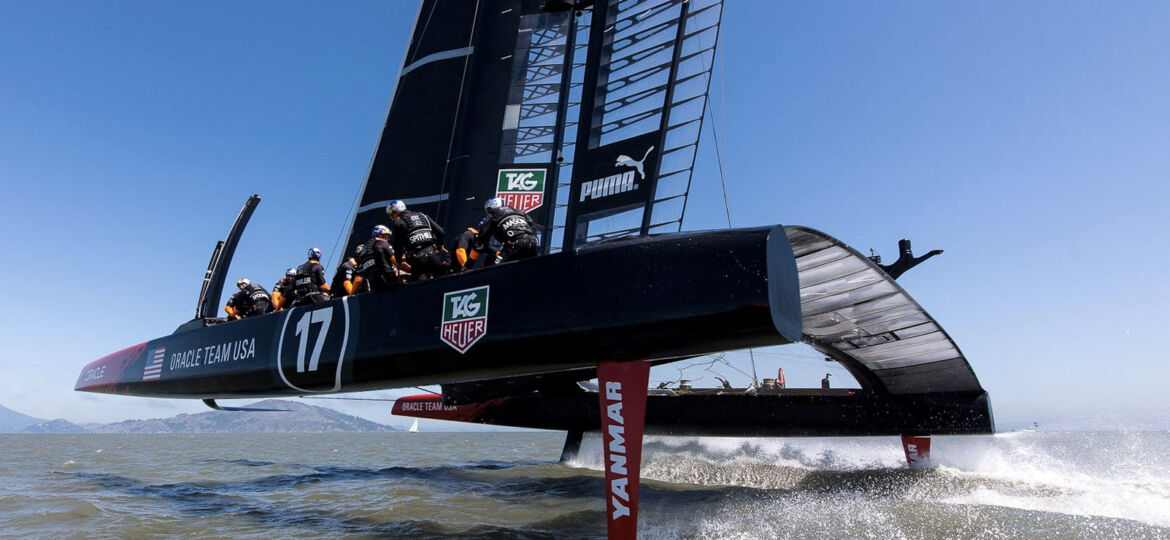
WHY THIS MATTERS IN BRIEF
- Today’s ultra expensive racing yachts don’t float, they fly, and this years America’s cup could see the first time a boats’ hull never hits the water
As far as sporting trophies go, it’s hard to find any older than the America’s Cup. Sailing teams have been fighting over the ornate, sterling silver trophy since 1851, but while Queen Victoria would recognize the “Auld Mug” today, it’s unlikely she would recognise today’s ultra modern sailing yachts as boats.
These vessels are like luxury yachts in the same way that Formula 1 cars are like family sedans – they drive, and the similarities stop there. The folks, most of them billionaires, like Oracle’s Larry Ellison, who are eager to win sailing’s greatest prize sink fortunes, in some cases hundreds of millions of dollars, into discovering and using the latest technologies and materials, to build vessels that don’t so much plow through the water as fly above it.
Yesterday, America’s Cup defending champion Oracle Team USA unveiled the boat it will take to the briny deep in 2017 and it looks like two black and red missiles, bound together with a lattice of carbon fiber tubing, and towered over by a fabric sail which is the only conventional element. If it seems ready to take flight, it might be because Oracle tapped aviation giant Airbus to fine tune the design.
The yacht, dubbed AC50, is in some ways a tamer version of the design that won the last America’s Cup, but was criticised for being so powerful, even pro sailors had trouble handling it. In the 2013 races in San Francisco, several boats crashed and one sailor died. So this newcomer is 50 feet long instead of 72, and demands a crew of six, not 11.
But the heart of what makes these yachts so fierce has only been strengthened. America’s Cup Class catamarans use lift generated over a hydrofoil suspended under the hull, like a wing under water, to boost the boat up out of the waves and make it fly. Instead of pushing its hull through the water, the yacht skims the surface, riding on what look like little feet.
“You just have this little hokey stick foil section cutting through the water,” says Aaron Perry, Oracle Team USA designer, who has spent the last year and a half in Bermuda developing the new boat. Less drag equals more speed, which is why velocities have doubled since yachts started using hydrofoils. In 2013, Team Emirates topped 50 mph. Despite the smaller boats, this year’s racers are likely to go even faster.
There’s not much room for creativity to make that happen. The 50 page design guidelines demand every boat be identical, save a few key elements, including the hydrofoil shape and control systems. So that’s where Airbus engineers focused their aerodynamics expertise.
“What is amazing for an aeronautical engineer like me is that the technology used to design these flying boats is very similar to the ones we’re using to develop and test aircraft,” says Pierre Marie Belleau, Airbus’ head of business development and a keen sailor himself.
The planemaker even invited Oracle to experiment with its foils at its Hamburg testing facilities. They put them through some vibration, torsion, and bending tests, as well as a pressure test to breaking point – treatment usually reserved for commercial airliner wings.
The result? Where the old boat could only “fly” when going downwind, Oracle has nearly perfected how to rest on its foils no matter the conditions.
“The boats are completing practice races without coming off the foils,” Perry says, “the hulls are now almost irrelevant.”
The defending champions, not wanting to leave anything to chance, also worked with BMW to integrate a steering system derived from touring car racing. Applying the semi-automated systems designed for automotive applications, the engineers made a yacht that responds to a turn of the wheel nearly instantaneously – instead of taking two seconds.
Even with all the technology and trials, on race day, it will come down to human factors.
“It’s been a combination of getting time on the water, and really good crew work,” says Perry, “to get around the racecourse without touching down off the foils requires a kind of a symphony.”
Everything has to happen with perfect timing, adjusting and trimming on the fly. The sailors still matter.
And they’re in for a challenge. Oracle Team USA will face challenges from teams from the UK, France, Sweden, New Zealand, and Japan, vying for the chance to wrest the ancient trophy away when qualifiers start in May.
















[…] Source link […]
[…] the years we’ve seen some pretty fast boat designs hitting the water – from yachts that “fly” to the use of air bubbles and supercavitation that help stealth speed boats, and even torpedoes, […]